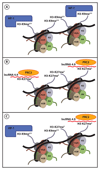Cytomegalovirus latency and reactivation: recent insights into an age old problem
- PMID: 26572645
- PMCID: PMC5458136
- DOI: 10.1002/rmv.1862
Cytomegalovirus latency and reactivation: recent insights into an age old problem
Abstract
Human cytomegalovirus (HCMV) infection remains a major cause of morbidity in patient populations. In certain clinical settings, it is the reactivation of the pre-existing latent infection in the host that poses the health risk. The prevailing view of HCMV latency was that the virus was essentially quiescent in myeloid progenitor cells and that terminal differentiation resulted in the initiation of the lytic lifecycle and reactivation of infectious virus. However, our understanding of HCMV latency and reactivation at the molecular level has been greatly enhanced through recent advancements in systems biology approaches to perform global analyses of both experimental and natural latency. These approaches, in concert with more classical reductionist experimentation, are furnishing researchers with new concepts in cytomegalovirus latency and suggest that latent infection is far more active than first thought. In this review, we will focus on new studies that suggest that distinct sites of cellular latency could exist in the human host, which, when coupled with recent observations that report different transcriptional programmes within cells of the myeloid lineage, argues for multiple latent phenotypes that could impact differently on the biology of this virus in vivo. Finally, we will also consider how the biology of the host cell where the latent infection persists further contributes to the concept of a spectrum of latent phenotypes in multiple cell types that can be exploited by the virus.
Copyright © 2015 John Wiley & Sons, Ltd.
Figures



References
-
- Griffiths P, Baraniak I, Reeves M. The pathogenesis of human cytomegalovirus. J Pathol. 2015;235:288–297. - PubMed
-
- Jackson SE, Mason GM, Wills MR. Human cytomegalovirus immunity and immune evasion. Virus Res. 2011;157(2):151–60. - PubMed
-
- Legendre C, Pascual M. Improving outcomes for solid-organ transplant recipients at risk from cytomegalovirus infection: late-onset disease and indirect consequences. Clin Infect Dis. 2008;46(5):732–40. - PubMed
-
- Kenneson A, Cannon MJ. Review and meta-analysis of the epidemiology of congenital cytomegalovirus (CMV) infection. Rev Med Virol. 2007;17(4):253–76. - PubMed
-
- Boeckh M, Nichols WG. The impact of cytomegalovirus serostatus of donor and recipient before hematopoietic stem cell transplantation in the era of antiviral prophylaxis and preemptive therapy. Blood. 2004;103(6):2003–8. - PubMed
Publication types
MeSH terms
Grants and funding
LinkOut - more resources
Full Text Sources
Other Literature Sources
Medical
Molecular Biology Databases

